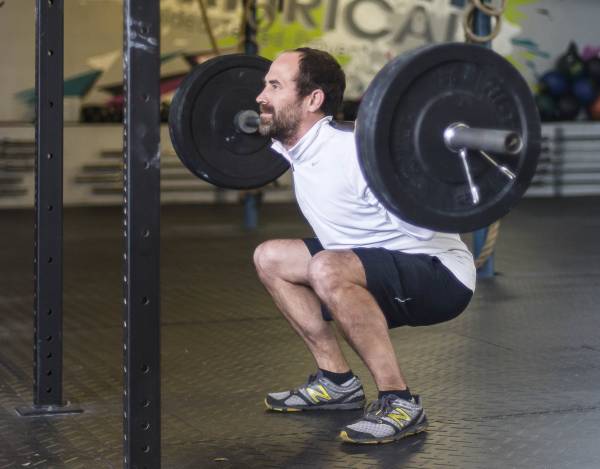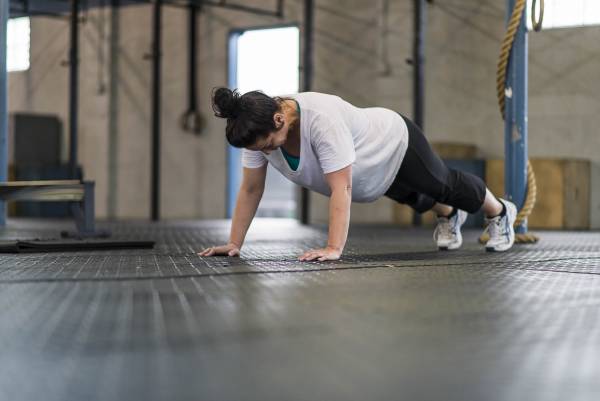There are two types of runners: those who just run and those who are well-balanced athletes.
Those in the latter group cross-train and perform strength training. They’re usually stronger, healthier, and more successful athletes who are able to keep reaching new levels of performance. On the other hand, the runners who just run tend to get injured often and wonder why they aren’t able to make much progress over the long term.
Which athlete would you rather be?
Runner-Specific Strength Training
Of all the things that influence your running, strength training is one of the biggest factors that will impact your health, fitness, and performance. Unfortunately, a lot of runners avoid strength training because they’ve been taught they just need to run or that getting stronger will “bulk them up” and slow them down.
Runner-specific strength training is actually one of the best things you can spend your valuable training time doing. And fortunately, you don’t need to train like a bodybuilder or strongman to get the benefits. Applying a few key strategies can help you get stronger, stay healthy, and race faster.
The Benefits of Strength Training for Runners
Strength work is the perfect complement to a runner’s training plan and what I consider to be ideal cross training. One of the primary benefits is that it’s a superb tool for injury prevention. Given that runners tend to experience alarmingly high injury rates, it is perhaps the most useful cross training method for them.
“Strengthening the hips and glutes is one of the best injury prevention measures a runner can take.”
The stronger you get, the more resilient your body will become to the demands of running. The repetitive impact of running won’t wear you down as much. Plus, when you’ve got a strong body, any preexisting conditions will be less likely to worsen. This is because strength training helps to improve structural weaknesses in your body, whether in the muscles, joints, or connective tissues. Often, this will eliminate the source of many common running injuries.
For example, patellofemoral pain syndrome (also known as runner’s knee) can be caused by hip dysfunction – tight or weak hips cause compensations elsewhere that result in knee injuries. Strengthening the hips and glutes is one of the best injury prevention measures a runner can take.
But there are even more benefits to be had from a small, targeted dose of strength training. Strength training also builds core strength, which is particularly important for distance runners. A strong core will not only look great, it’ll also help contribute to better posture throughout the day and while running. This means you’ll be a more efficient runner.
“Whether you simply want to run pain-free or you want to shave some time off your favorite distance, strength training will help.”
Finally, strength training will help you run faster. By improving your efficiency, allowing you to impart more force into the ground, and train healthy for longer periods of time, you’ll finish races faster than ever before.
Whether you simply want to run pain-free or you want to shave some time off your favorite distance, strength training will help. Plus, you’ll enjoy many of the other benefits that come with strength training, such as higher energy levels, increased bone density, a stronger metabolism, and less body fat.

Getting Started With Strength Training
There are many effective ways to implement strength training. In the beginning, what’s most important is that you just do something and figure out what works best for you.
Your body will adapt to any kind of resistance, and it doesn’t matter where that resistance comes from (e.g. free weights at the gym, bodyweight exercises in your living room, or a kettlebell workout). You don’t need a perfectly periodized program designed for an elite athlete to receive the benefits of strength training.
Usually, a simple approach is best, especially in the beginning. Start with just ten minutes of basic strength exercises after your runs and you’ll experience the rewards.
The Best Strength Exercises for Runners
If you have a gym membership or equipment at home, then weight lifting exercises are a great choice. Focus on compound exercises that work multiple muscle groups, such as squats, deadlifts, bench press, and overhead press. If you have access to a pull up bar, then pull ups, chin ups, and hanging knee or leg raises are great choices, too.
“Focus on compound exercises that work multiple muscle groups, such as squats, deadlifts, bench press, and overhead press.”
You can also do all sorts of bodyweight exercises, which are superb options for runners for many reasons. You can do planks, side planks, bird dogs, glute bridges, mountain climbers, push ups, bodyweight squats, and lunges.
To start, pick four to six exercises from the suggestions above and perform one to three sets of each one based on your ability. Don’t worry about adhering to a specific format of sets and reps. What matters most is that you work hard, perform a variety of exercises that target all the major muscle groups, and progress from week to week by making the workouts longer or adding weight.
When you get a little more comfortable with the exercises, you can begin to put them into a more formal workout. Here are a couple of examples.
Sample Gym Workout for Runners
- Barbell back squats – 1-2 sets
- Barbell deadlifts – 1-2 sets
- Overhead dumbbell press – 1-2 sets
- Pull ups, chin ups, or dumbbell rows – 1-2 sets
- Front plank – 1 max duration hold
- Side planks – 1 max duration hold per side
Notes: Select weights that you can lift for about 4-6 reps, and stop each set either 1-2 reps before you reach muscle failure or if your form breaks down. Rest for 2-3 minutes between sets.

Sample Home Workout for Runners
Repeat the following circuit 2-3 times, with no rest between exercises and 1-2 minutes rest between circuits:
- Bodyweight squats
- Push ups
- Walking lunges
- Side plank (both sides)
- Glute bridges
Notes: Perform all sets until you’ve reached about 80% of your maximum effort.
One or two ten- or twenty-minute sessions per week will be more than enough for most beginners. As you progress, you can increase the duration and frequency of your sessions to make them more challenging.
Remember not to overwhelm yourself during the first few weeks. It’s fine to ease into strength training slowly if you haven’t been doing it regularly before. See how your body responds.
Summary
If you’re ready to upgrade from often-injured, slower runner to a healthy, faster athlete, then strength training is one of the best ways to get there. If you’re an injury-prone runner or if you’re putting in a lot of mileage, then strength work is a no-brainer. You’ll be able to run more, experience fewer overuse injuries, and race faster. And who doesn’t want that?
Check out these related articles:
- The Single Secret to Becoming a Better Runner
- The 5 Most Common (and Most Preventable) Running Injuries
- 5 Essential Yoga Poses for Runners
- What’s New On Breaking Muscle Today
Photos courtesy of CrossFit Empirical.






